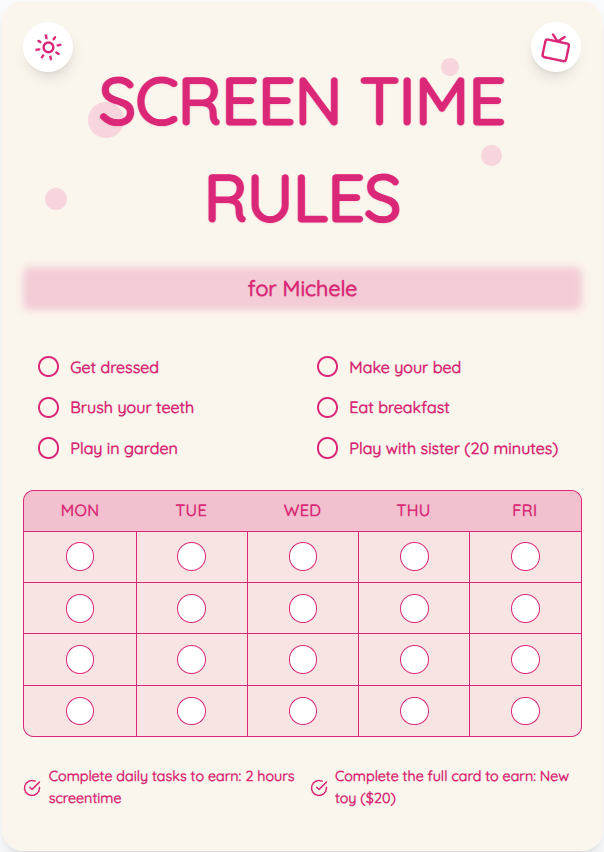Unlocking Screen Time Management: Empowering Parents to Find Balance
As a parent, navigating the digital landscape with your child can be challenging. Finding the right balance between screen time and other activities is crucial for their development and well-being. In this guide, we'll provide actionable advice to help you unlock effective screen time management for your children aged 2-12.
See What Your Screen Time Chart Will Look Like
Here's an example of a beautiful, customizable screen time rules chart you can create for your family

Understanding Screen Time Guidelines
Before diving into practical tips, it's essential to understand the recommended screen time guidelines for children. The American Academy of Pediatrics suggests limiting screen time to one hour per day for children ages 2-5, focusing on high-quality programming. For older children, consistent limits and monitoring content become more critical.
Creating a Screen Time Routine
Establishing a screen time routine can help set clear boundaries for your child. Designate specific times of the day for screen use, such as after homework or before bedtime. Incorporate non-screen activities like outdoor play, reading, or family time to promote a healthy balance.
Put These Tips Into Action
Create a custom chart to implement these strategies with your child
Using Screen Time Charts as Visual Aids
Screen time charts are valuable tools for both parents and children. These visual aids help track and limit screen time effectively. Utilize our ScreenTimeRules.com screen time chart generator to create personalized charts that align with your family's rules and routines.
Encouraging Alternative Activities
Encourage your child to engage in alternative activities that promote physical, mental, and social development. Encouraging hobbies, sports, creative play, and reading can reduce screen time dependency and enhance overall well-being.
Practical Tips for Success
- Set clear screen time rules and communicate them with your child.
- Engage in screen time activities together to monitor content and bond.
- Use positive reinforcement to reward adherence to screen time limits.
- Create a tech-free zone in certain areas of your home.
Frequently Asked Questions
How can I handle resistance from my child when enforcing screen time limits?
It's common for children to resist limits on screen time. Stay consistent, offer alternative activities, and explain the benefits of balanced tech use. Involving them in setting rules can also increase compliance.
Is it okay to use screen time as a reward for good behavior?
While using screen time as a reward can be effective, it's essential to strike a balance. Avoid making screens the sole motivator and incorporate other rewards like quality time together or small treats.
How do I handle disagreements with my co-parent regarding screen time rules?
Open communication and compromise are key when co-parents have differing views on screen time. Find common ground, consider expert recommendations, and prioritize your child's well-being in reaching a consensus.
Unlocking effective screen time management is a journey that requires patience, consistency, and adaptability. By implementing the tips and strategies outlined in this guide, you can create a healthy tech balance for your child. Remember, utilizing tools like screen time charts can simplify the process and promote family harmony. Embrace the opportunity to guide your child's digital habits positively today!
Ready to Transform Your Family's Screen Time?
Join thousands of parents who have successfully managed screen time with our customizable charts.
